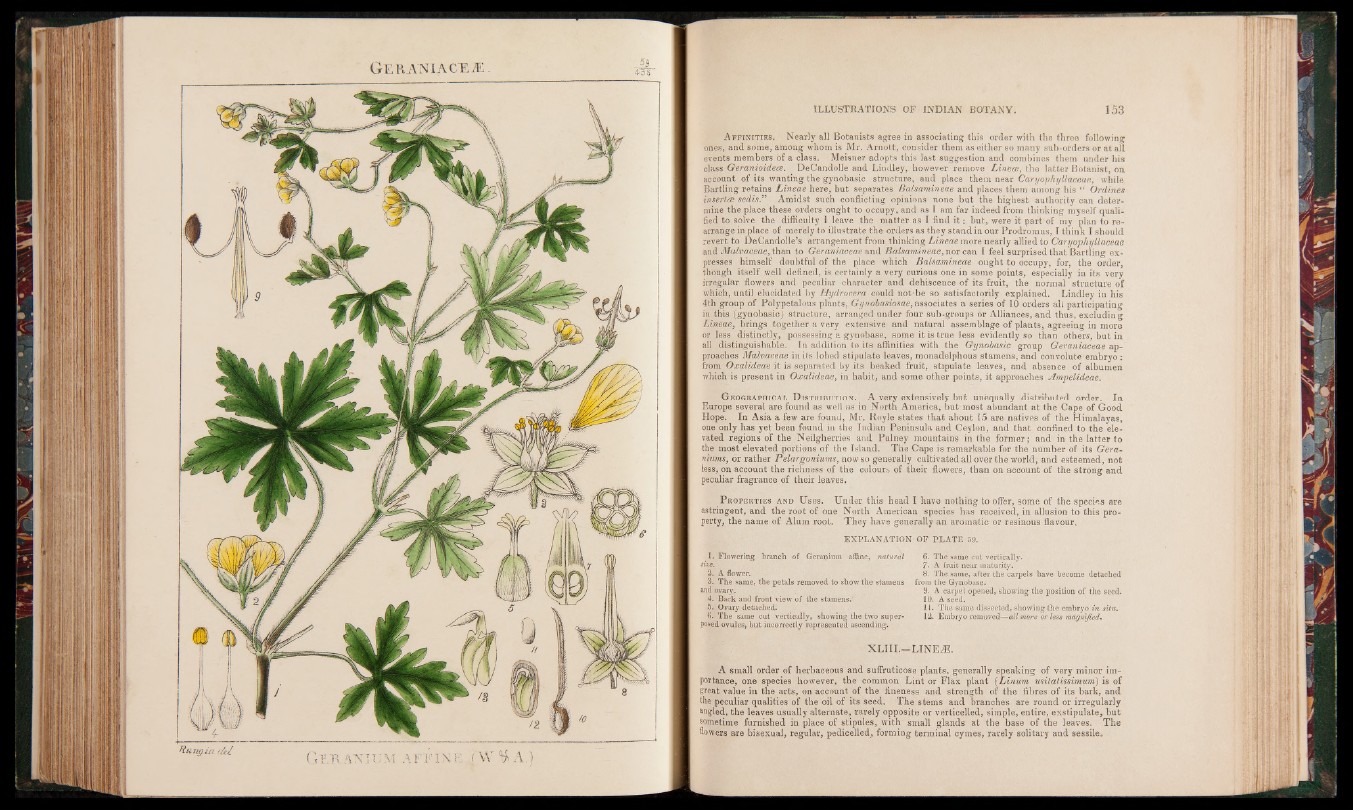
Affinities. Nearly all Botanists agree in associating this order with the three following
ones, and some, among whom is Mr. Arnott, consider them as either so many sub-orders or at all
events members of a class. Meisner adopts this last suggestion and combines them under his
class Geranioidece. DeCandolle and Lindley, however remove Linece, the latter Botanist, on
account of its wanting the gynobasic structure, and place them near Caryophyllaceae, while
Bartling retains Lineae here, but separates Balsamineae and places them among his “ Ordines
ivsertce sedis.” Amidst such conflicting opinions none but the highest authority can determine
the place these orders ought to occupy, and as I am far indeed from thinking myself qualified
to solve the difficulty l leave the matter as I find it: but, were it part5of my plan to rearrange
in place of merely to illustrate the orders as they stand in our Prodromus, I think I should
revert to DeCandolle’s arrangement from thinking Lineae more nearly allied to Caryophyllaceae
and Malvaceae, than to Geraniaceae and Balsamineae, nor can I feel surprised that Bartling expresses
himself doubtful of the place which Balsamineae ought to occupy, for, the order,
though itself well defined, is certainly a very curious one in some points, especially in its very
irregular flowers and peculiar character and dehiscence of its fruit, the normal structure of
which, until elucidated by Hydrocera could not-be so satisfactorily explained. Lindley in his
4th group of Polypetalous plants, Gynobasiosae, associates a series of 10 orders all participating
in this (gynobasic) structure, arranged under four sub-groups or Alliances, and thus, excluding
Lineae, brings together a very extensive and natural assemblage of plants, agreeing in more
or less distinctly, possessing a gynobase, some it is true Jess evidently so than others, but in
all distinguishable. In addition to its affinities with the Gynobasic group Geraniaceae approaches
Malvaceae in its lobed stipulate leaves, monadelphous stamens, and convolute embryo:
from Oxalideae it is separated by its beaked fruit, stipulate leaves, and absence of albumen
which is present in Oxalideae, in habit, and some other points, it approaches Ampelideae.
G eographical D istribution. A very extensively but unequally distributed order. In
Europe several are found as well as in North America, but most abundant at the Cape of Good
Hope. In Asia a few are found, Mr. Royle states that about 15 are natives of the Himalayas,
one only has yet been found in the Indian Peninsula and Ceylon, and that confined to the elevated
regions of the Neilgherries and Pulney mountains in the former; and in the latter to
the most elevated portions of the Island. The Cape is remarkable for the number of its Geraniums,
or rather Pelargoniums, now so generally cultivated all over the world, and esteemed, not
less, on account the richness of the colours of their flowers, than on account of the strong and
peculiar fragrance of their leaves.
P roperties and Uses. Under this head I have nothing to offer, some of the species are
astringent, and the root of one North American species has received, in allusion to this property,
the name of Alum root. They have generally an aromatic or resinous flavour.
EXPLANATION OF PLATE 59.
1. Flowering branch of Geranium affine, natural 6. The same cut vertically.
***«. 7• A fruit near maturity.
2. A flower. 8. The same, after the carpels have become detached
3. The same, the petals removed to show the stamens from the Gynobase.
and .ovary. 9. A carpel opened, showing the position of the seed.
4. Back and front view of the stamens.' 10. A seed.
.5. Ovary detached. 11. The same dissected, showing the embryo in situ.
6. The same cut vertically, showing the two super- 12. Embryo removed—all more or less magnified.
posed ovules, but incorrectly represented ascending.
XLIII.—LINEJE.
A small order of herbaceous and suffruticose plants, generally speaking of very minor importance,
one species however, the common Lint or Flax plant (Linum usitatissimum) is of
great value in the arts, on account of the fineness and strength of the fibres of its bark, and
the peculiar qualities of the oil of its seed. The stems and branches are round or irregularly
angled, the leaves usually alternate, rarely opposite or verticelled, simple, entire, exstipulate, but
sometime furnished in place of stipules, with small glands at the base of the leaves. The
nowers are bisexual, regular, pedicelled, forming terminal cymes, rarely solitary and sessile.